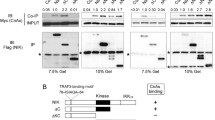Abstract
TNFAIP1 is a protein which can be induced by tumor necrosis factorα (TNFα) and interleukin-6 (IL-6), it may play roles in DNA synthesis, DNA repair, cell apoptosis and human diseases. However, very little has been known about how TNFAIP1 acts in these physiological processes. In this paper, CK2β was identified as a partner of TNFAIP1 by screening the HeLa cDNA library in yeast two-hybrid system with TNFAIP1 as a bait. Furthermore, it was demonstrated that CK2 could phosphorylate TNFAIP1 in vitro and in vivo, which facilitated the distribution of TNFAIP1 in nucleus and enhanced its interaction with PCNA. It is suggested that the phosphorylation of TNFAIP1 may be required for its functions.




Similar content being viewed by others
References
Wolf FW, Marks RM, Sarma V, Byers MG, Katz RW, Shows TB, Dixit VM (1992) Characterization of a novel tumor necrosis factor-alpha-induced endothelial primary response gene. J Biol Chem 267:1317–1326
Jianlin Z, Ren K, Xin L, Xiwen X, Xiaoxiao H, Jian Z (2005) A novel PDIP1-related protein, KCTD10, that interacts with proliferating cell nuclear antigen and DNA polymerase δ. Biochim Biophys Acta 1729:200–203
Zhou J, Xiaoxiao H, Xiwen X, Xin L, Yunhai L, Ren K, Tieshan J, Xiang H, Jian Z (2005) Cloning of two rat PDIP1 related genes and their interactions with proliferating cell nuclear antigen. J Exp Zool 303A:227–240
He H, Tan CK, Downey KM, So AG (2001) A tumor necrosis factor alpha- and interleukin 6-inducible protein that interacts with the small subunit of DNA polymerase delta and proliferating cell nuclear antigen. Proc Natl Acad Sci USA 98:11979–11984
Link CD, Taft A, Kapulkin V, Duke K, Kim S, Fei Q, Wood DE, Sahagan BG (2003) Gene expression analysis in a transgenic Caenorhabditis elegans Alzheimer s disease model. Neurobiol Aging 24:397–413
Lin MC, Lee NP, Zheng N, Yang PH, Wong OG, Kung HF, Hui CK, Luk JM, Lau GK (2005) Tumor necrosis factor-alpha-induced protein 1 and immunity to hepatitis B virus. World J Gastroenterol 11:7564–7568
Yang LP, Zhou AD, Li H, Zhang WF, Wu YY, Zhang J, Han M (2006) Expression profile in the cell lines of human TNFAIP1 gene. Yi Chuan 28:918–922
Liu M, Sun Z, Zhou A, Li H, Yang L, Zhou C, Liu R, Hu X, Zhou J, Xiang S, Zhang J (2009) Functional characterization of the promoter region of human TNFAIP1 gene. Mol Biol Rep 11. doi:10.1007/s11033-009-9588-1
Ding X, Fan C, Zhou J, Zhong Y, Liu R, Ren K, Hu X, Luo C, Xiao S, Wang Y, Feng D, Zhang J (2006) GAS41 interacts with transcription factor AP-2beta and stimulates AP-2beta-mediated transactivation. Nucleic Acids Res 34:2570–2578
Chantalat L, Leroy D, Filhol O, Nueda A, Benitez MJ, Chambaz EM, Cochet C, Dideberg O (1999) Crystal structure of the human protein kinase CK2 regulatory subunit reveals its zinc finger-mediated dimerization. Embo J 18:2930–2940
Niefind K, Guerra B, Ermakowa I, Issinger OG (2001) Crystal structure of human protein kinase CK2: insights into basic properties of the CK2 holoenzyme. Embo J 20:5320–5331
Grasselli E, Tomati V, Bernasconi MV, Nicolini C, Vergani L (2004) C-terminal region of protein kinase CK2 alpha: how the structure can affect function and stability of the catalytic subunit. J Cell Biochem 92:270–284
Appel K, Wagner P, Boldyreff B, Issinger OG, Montenarh M (1995) Mapping of the interaction sites of the growth suppressor protein p53 with the regulatory beta-subunit of protein kinase CK2. Oncogene 11:1971–1978
Jensen HH, Hjerrild M, Guerra B, Larsen MR, Hojrup P, Boldyreff B (2001) Phosphorylation of the Fas associated factor FAF1 by protein kinase CK2 and identification of serines 289 and 291 as the in vitro phosphorylation sites. Int J Biochem Cell Biol 33:577–589
Litchfield DW (2003) Protein kinase CK2: structure, regulation and role in cellular decisions of life and death. Biochem J 369:1–15
Nousiainen M, Sillje HH, Sauer G, Nigg EA, Korner R (2006) Phosphoproteome analysis of the human mitotic spindle. Proc Natl Acad Sci USA 103:5391–5396
Pinna LA (1990) Casein kinase 2: an ‘eminence grise’ in cellular regulation? Biochim Biophys Acta 1054:267–284
Pinna LA, Meggio F (1997) Protein kinase CK2 (“casein kinase-2”) and its implication in cell division and proliferation. Prog Cell Cycle Res 3:77–97
Wang Y, Zheng Y, Luo F, Fan X, Chen J, Zhang C, Hui R (2009) KCTD10 interacts with proliferating cell nuclear antigen and its down-regulation could inhibit cell proliferation. J Cell Biochem 106:409–413
Krebs EG (1994) The growth of research on protein phosphorylation. Trends Biochem Sci 19:439
Hunter T (2000) Signaling-2000 and beyond. Cell 100:113–127
Acknowledgments
This work was supported by the 973 project of Ministry of Science and Technique of China (No. 2005CB522505, 2006CB943506, 2008CB517306), the National Natural Science Foundation of China (No. 90608006), the Hunan provincial doctorial innovative Foundation (2008XC065025), and the Hunan Provincial Natural Science Foundation of China (07JJ3075).
Author information
Authors and Affiliations
Corresponding author
Additional information
Liping Yang, Ning Liu and Xiang Hu are contributed equally to this work.
Rights and permissions
About this article
Cite this article
Yang, L., Liu, N., Hu, X. et al. CK2 phosphorylates TNFAIP1 to affect its subcellular localization and interaction with PCNA. Mol Biol Rep 37, 2967–2973 (2010). https://doi.org/10.1007/s11033-009-9863-1
Received:
Accepted:
Published:
Issue Date:
DOI: https://doi.org/10.1007/s11033-009-9863-1




